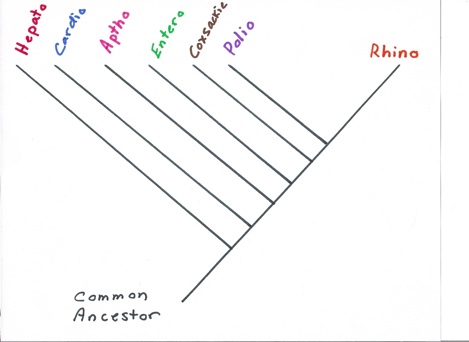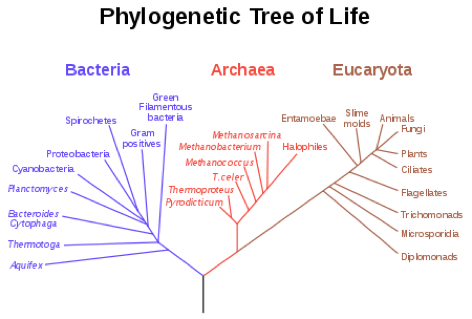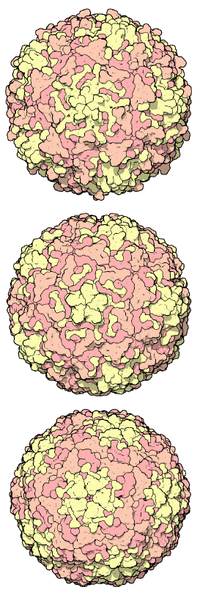The naming (taxonomy) of HRV and its relationship to other organisms (phylogeny)...


Taxonomic Classification
Viruses are named differently than most biological organisms. This is because of the inability to define some viruses as living or non-living. The taxonomy is similar to that of other organisms toward the more specific classifications, starting with order.
Common name – the actual virus itself does not have a common name. The pathology that this virus creates however is known as the common cold or “rhinitis” in medical terms.
Scientific name – Human rhinovirus
Below is the way in which HRV is classified:
RNA Viruses: Group IV
Order: Nidovirales
Family: Picornaviridae
Genus: Rhinovirus
Species: Human rhinovirus
Nidovirales – HRV is of the nidovirales order meaning “nested” virus.
Picorniviridae – This means that the virus itself contains a core of single-stranded RNA.
Rhinovirus – This virus is the cause of the common cold. Most commonly displayed as an upper respiratory tract (URT) infection.
Human rhinovirus – This virus infects vertebrates by means of using human cells as hosts for replication and ultimately causes the pathology associated with a cold.
There are more than 100 recognized serotypes of HRV. Because of this, it is possible for a host to succumb to multiple infections from this species of virus alone!
It is not entirely necessary to understand the above text in order to gain an understanding for the virus in general. The taxonomy described above examines how the organism is classified so that its relationship to other organisms can be determined. It also breaks down the names of these classification levels to explain the general characteristics of each grouping.
Since there are more than 100 recognized serotypes (strains) of HRV, it makes perfect sense as to why a person recovering from a cold has the potential to become ill in the future from infection by this same virus.

Phylogenetic Relationships
The above phylogenetic tree illustrates the relationship of HRV to other viruses. By looking at this tree, it can be determined that all of these viruses have evolved from a common ancestor and each branch point is where the characteristics differed from those of the common ancestor. By looking at this tree, it can be seen that HRV is most closely related to the genus known as Poliovirus.
This particular phylogenetic tree evaluates the relationships between the given groups of viruses at the molecular level. The % similarity in nucleotide identity is evaluated when determining which virus types are more closely related within this phylogenetic tree.

This is a phylogenetic tree that classifies the major living organisms on Earth and places each into one of three domains.
While looking at the above tree, the question that probably strikes you is “where are the viruses?” This is precisely the reason I felt it necessary to address this particular tree. As you may recall from previous pages in this website, HRV is not located in this tree of life due to the fact that it cannot be classified as living. When we look at the living organisms on this planet, they can be divided into three major domains: Bacteria, Archaea, and Eukarya. Since viruses cannot be considered living, they have no real place in this tree of life. This is an important concept to understand about viruses, because a virus must utilize the cell of a living host in order to complete its life cycle.
Human rhinovirus 14
This image compares three viruses from the Picornaviridae family:
Poliovirus (top)
Rhinovirus (middle)
A virus that causes foot and mouth disease in livestock (bottom).





